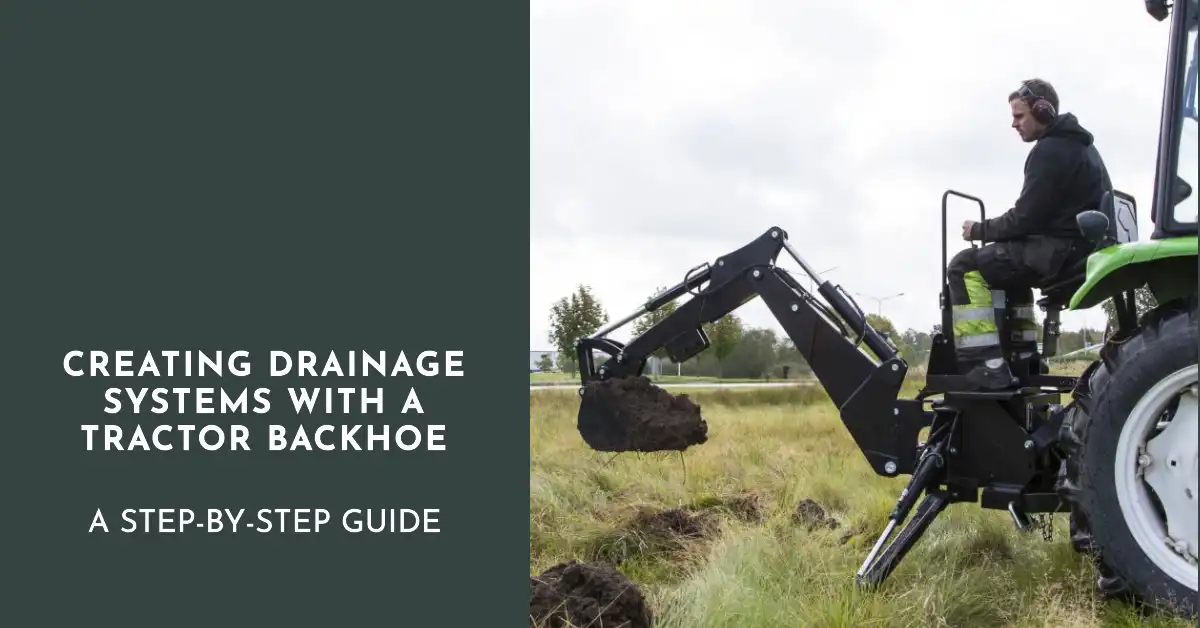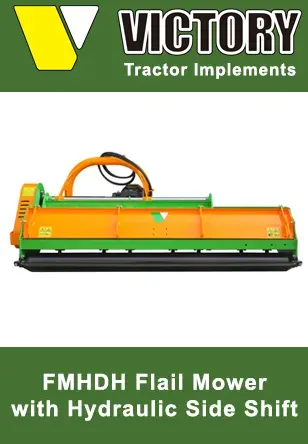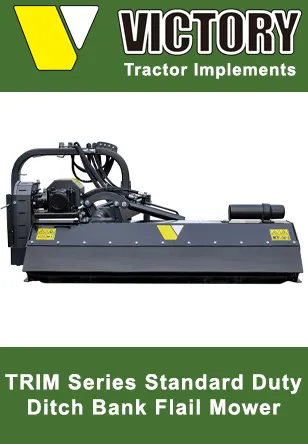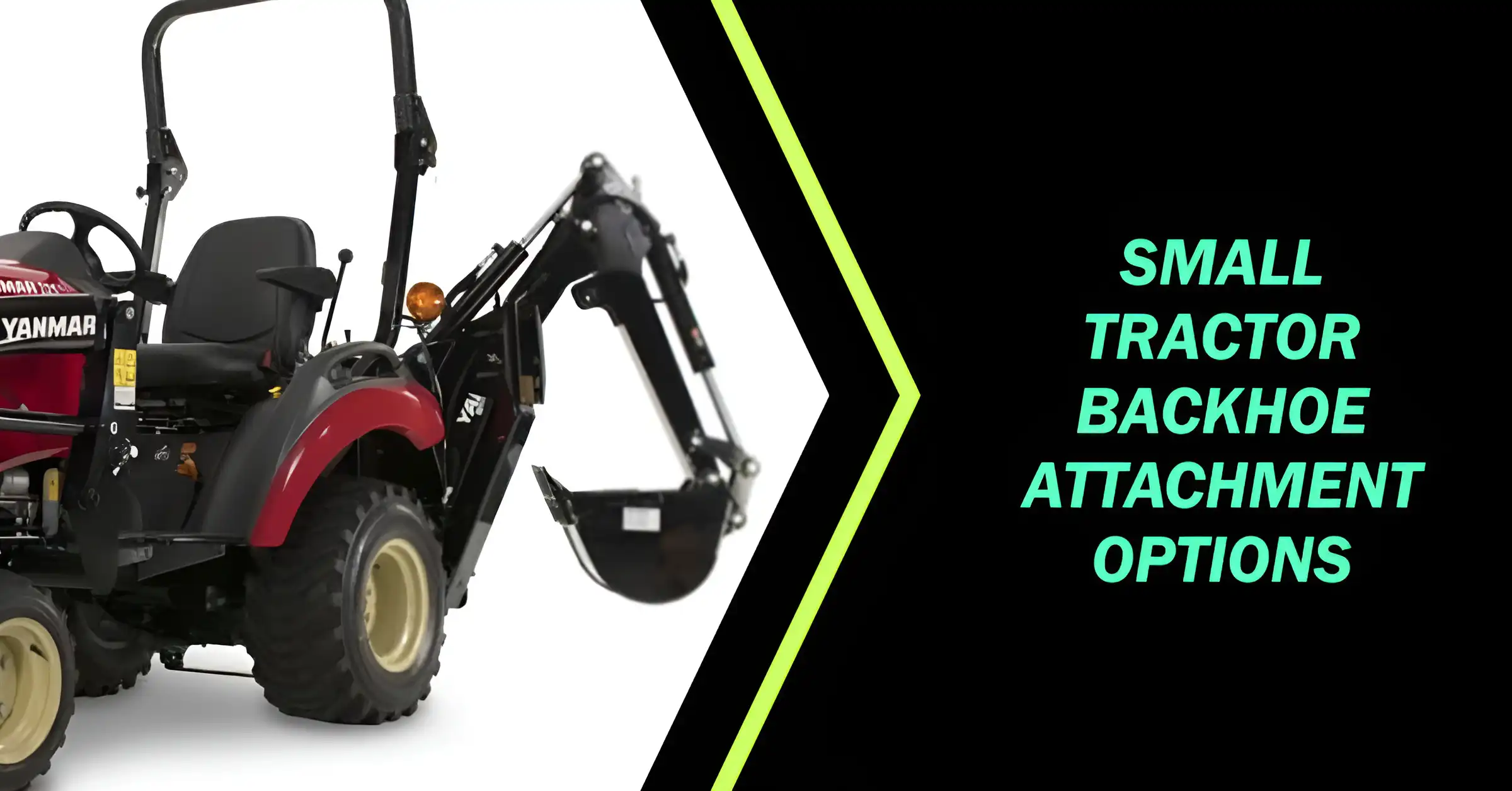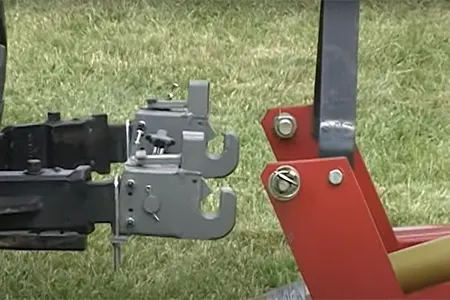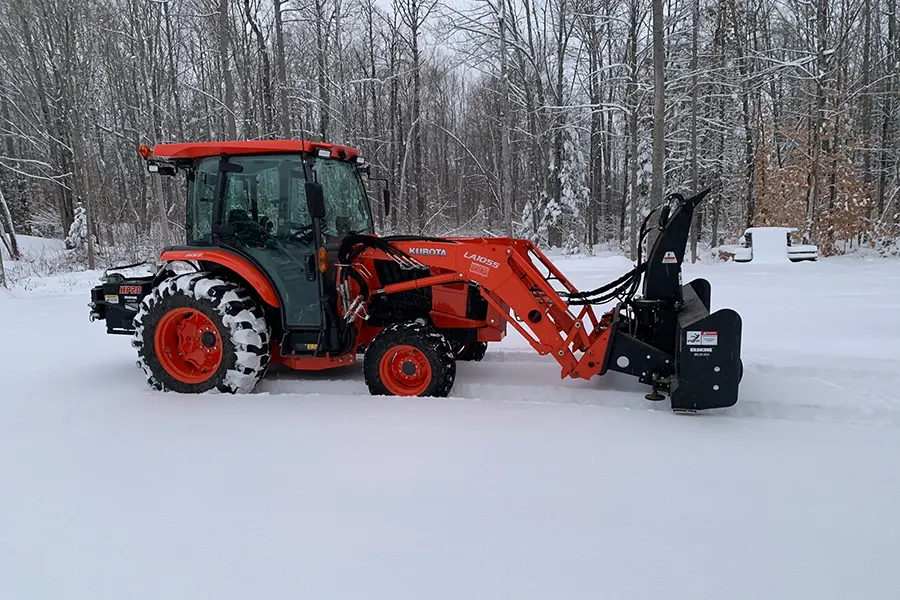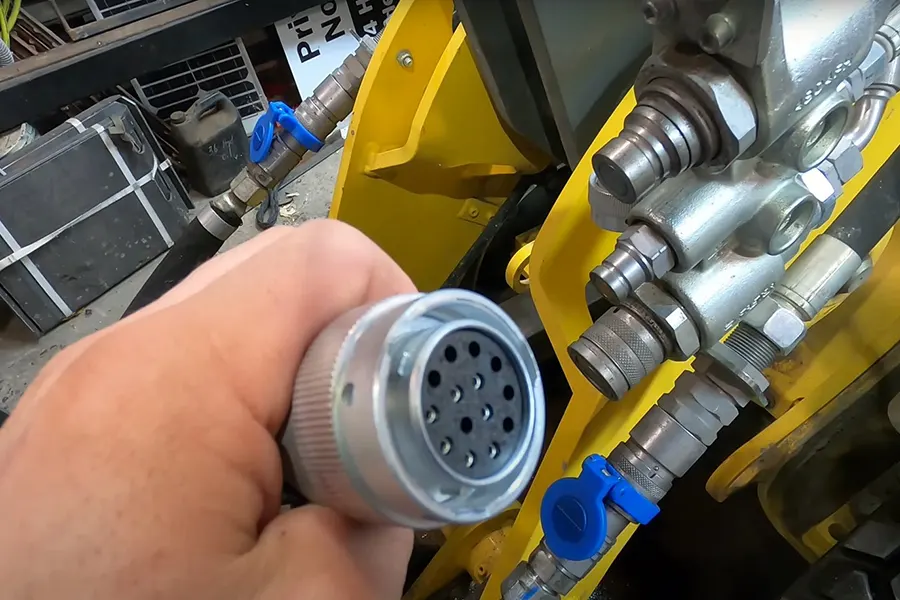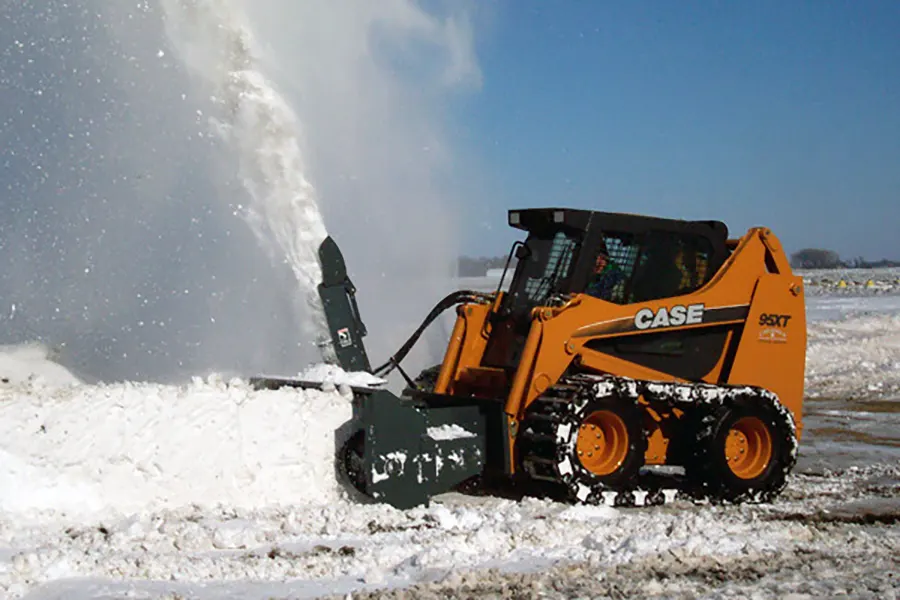When it comes to maintaining a healthy farm, creating drainage systems is crucial for preventing standing water from accumulating and causing damage to your crops, soil, and buildings. Using a tractor backhoe is an efficient way to dig trenches, install drainage pipes, and ensure proper water flow on your property. In this step-by-step guide, we will help you to create a drainage system using a tractor backhoe, like the BHX-6 Backhoe Attachment, BHX-7 Tractor Backhoe, or the BHX-8 3-Point Backhoe.
| Key Point | Summary |
|---|---|
| Planning Your Drainage System | Before digging, identify the issues you want to address, the best place for trenches or drainage pipes, and the right tools for the job. |
| Marking Your Digging Area | Use stakes and string to map out your trench or drainage pipe route, accounting for obstacles. |
| Preparing Your Tractor Backhoe | Check the hydraulic system, attach the backhoe, and inspect the teeth and bucket before starting any digging. |
| Digging the Trench | Position your tractor, lower the stabilizers, start the tractor at a slow speed, and gradually dig the trench, maintaining a consistent depth and width. |
| Installing Drainage Pipe | If applicable, position the drainage pipe along the bottom of the trench, fill the trench with gravel or coarse stone, and ensure the pipe has a suitable outfall location. |
| Filling the Trench | Fill the trench with soil, gravel, or other suitable materials, and ensure a smooth finish. |
| Restoring the Area | Remove excess soil or debris, replant disrupted grass or crops, and repair any damage to the surrounding landscape. |
| Monitoring and Maintaining Your Drainage System | Regularly inspect the area after heavy rain, keep the trench and drainage pipe clear of debris, inspect the outfall location, and repair any damage. |
| Considering Additional Equipment | To improve farm management, consider investing in additional equipment like rotary tillers, flail mowers, and wood chippers. |
| Implementing Best Farm Management Practices | Stay updated with the latest farm management practices, focusing on soil health, crop rotation, and efficient irrigation systems. |
| Networking with Other Farmers and Industry Experts | Share experiences, tips, and insights with other farmers and industry experts through workshops, online forums, and publications. |
| Reviewing and Updating Your Drainage System Plan | Regularly review and update your drainage system plan as your farm evolves over time. |
Step 1: Plan Your Drainage System
Before you start digging, it’s important to spend some time planning out your drainage system. This will help you avoid any unnecessary work and ensure that you accomplish your project efficiently. Here are a few things you should consider during the planning stage:
• Determine the primary issue you want to address: Excess water can cause damage in different ways. Are you looking to direct water away from buildings or protect specific areas of your crops?
• Identify the best place for your trenches or drainage pipes: Make sure to consider the natural slope of the land. Water will always follow the path of least resistance, so you want to use the landscape to your advantage.
• Choose the right tools for the job: Using a tractor backhoe is the recommended method for creating drainage systems, as it provides powerful digging capabilities and precise control. Victory Tractor Implements offers a variety of tractor backhoe attachments and rotary tillers to meet your specific needs.
Step 2: Mark Your Digging Area
Once you have a plan in place, the next step is to mark out the area where you’ll be digging. Use stakes and string to map out your trench or drainage pipe route, making sure to account for any obstacles, like trees or large rocks. This will also provide you with a clear visual guide while using your tractor backhoe.
Step 3: Prepare Your Tractor Backhoe
Before starting any digging, it’s important to ensure your tractor and backhoe attachment are properly prepared. This includes:
• Checking the hydraulic system: Make sure your tractor has enough hydraulic fluid and that there are no leaks in the system.
• Attaching the backhoe: Properly connect your tractor backhoe attachment, such as the BH-6 Backhoe Attachment or the BH8 3-Point Backhoe, and double check all connections and hardware.
• Inspecting the teeth and bucket: Check the digging teeth and bucket for any signs of wear or damage. If needed, you can sharpen or replace the teeth for better digging performance.
With your tractor backhoe ready to go, it’s time to start digging. It’s important to approach the digging process with patience and precision, ensuring that you create a smooth, uniform trench that will effectively direct water away from your desired locations.
Step 4: Dig the Trench
To dig the trench, follow these steps:
1. Position your tractor at the start of your marked digging area, lining up the backhoe with the trench line.
2. Lower the stabilizers to stabilize the tractor and backhoe.
3. Start up your tractor at a slow speed to let the backhoe warm up.
4. Gradually lower the backhoe bucket into the ground and begin digging, following the marked path.
5. As you dig, maintain a consistent depth and width for the trench to ensure proper water flow.
6. When your bucket becomes full, slowly lift it out of the trench and deposit the soil in a designated spoils area.
7. Repeat this process until the trench is completed.
Remember to take your time and focus on precision. Rushing may result in an uneven trench that may not properly direct water away from your desired areas.
Step 5: Install Drainage Pipe (Optional)
In some cases, using drainage pipes can help to further improve water flow in your drainage system. If you decide to use a drainage pipe, follow these steps:
1. Roll out and position the drainage pipe along the bottom of the trench, with the holes facing down.
2. Use gravel or coarse stone to fill the trench, surrounding the pipe and covering it by about 2-3 inches. This will provide additional support and facilitate water flow.
Make sure that the drainage pipe is properly connected and has a suitable outfall location, such as a catch basin or swale.
Step 6: Fill the Trench
Once the trench is dug and, if applicable, the drainage pipe is in place, it’s time to fill the trench with soil, gravel, or other suitable materials. To do this, follow these steps:
1. Use a tractor attachment, such as a rotary tiller, to break up the soil that was initially removed from the trench.
2. Gradually fill the trench, taking care to evenly distribute the soil or filling material.
3. Use a rake, shovel, or your tractor bucket to level and compact the soil, ensuring a smooth finish.
Step 7: Restore the Area
After completing the trench, it’s important to restore the area to its original condition. This includes:
• Removing any excess soil or debris.
• Replanting grass or crops that may have been disrupted during the digging process.
• Repairing any damage caused to the surrounding landscape.
Following these steps will help you create an effective drainage system using your tractor backhoe. Victory Tractor Implements offers a range of tractor attachments and farm equipment that can help you tackle various projects on your farm. Whether you need a tractor backhoe, flail mower, or wood chipper, they have you covered. Make sure to check out their website for additional information and resources on maintaining your farm and equipment.
Step 8: Monitor and Maintain Your Drainage System
Creating a drainage system is not a one-time task. To ensure the effectiveness and longevity of your system, it is essential to monitor and maintain it regularly. Here’s how to do it:
1. Inspect the area after heavy rain: Observe how well the drainage system is working. Look for any signs of standing water, waterlogging, or erosion. This will help you identify any issues and make adjustments as needed.
2. Keep the trench and drainage pipe clear of debris: Soil, leaves, and other debris can accumulate and clog your drainage system. Regularly check and clear any obstructions to ensure optimal water flow.
3. Inspect the outfall location: Make sure the outfall location, such as a catch basin or swale, is clear of debris and functioning properly.
4. Repair any damage: If you notice any damage to the drainage system, make timely repairs to prevent further issues.
With proper monitoring and maintenance, your drainage system will continue to protect your farm from excess water damage.
Step 9: Consider Additional Equipment for Improved Farm Management
A well-functioning drainage system is just one aspect of maintaining a healthy and productive farm. To further improve the efficiency and effectiveness of your farm management, consider investing in additional equipment and attachments. Victory Tractor Implements offers a range of farm equipment to suit your specific needs:
• Rotary tillers: Perfect for preparing seedbeds, incorporating fertilizer, and breaking up compacted soil.
• Flail mowers: Ideal for managing overgrown fields, mowing rough areas, and mulching grass and vegetation.
• Wood chippers: Efficiently dispose of tree limbs, branches, and other organic debris.
By investing in quality equipment, you can streamline your daily tasks and significantly improve the productivity and sustainability of your farm.
Step 10: Research and Implement Best Farm Management Practices
Continuously learning about and implementing the latest farm management practices will help you to optimize your farm’s performance and sustainability. Some areas of focus include:
• Soil health: Regularly test your soil and implement strategies to improve its fertility and structure.
• Crop rotation: Rotate your crops to reduce soil erosion, replenish nutrients, and manage pests.
• Irrigation systems: Implement efficient watering systems, such as drip irrigation or center pivot, to conserve water and reduce waterlogging.
Staying up-to-date with the latest research and innovations will help you make informed decisions for your farm, ultimately leading to improved yield and sustainability.
Step 11: Network with Other Farmers and Industry Experts
Connect with other farmers and industry experts to share experiences, tips, and insights related to farm management, drainage systems, and equipment. This can help you expand your knowledge and discover new techniques to improve your farming operations.
There are a variety of ways to network, such as:
• Attending local workshops, conferences, and trade shows.
• Joining online forums or social media groups dedicated to farming.
• Subscribing to publications and newsletters from reputable sources in the industry.
By staying connected with other farmers and Implement Experts, you can continuously expand your knowledge on essential farm management topics.
Step 12: Periodically Review and Update Your Drainage System Plan
As your farm evolves over time, it’s important to review and update your drainage system plan. Factors such as changing weather patterns, expansion of your farm, or the addition of new buildings and structures may require adjustments to your existing drainage system.
Conduct periodic reviews of your drainage system plan to ensure it continues to meet your farm’s needs. This will help you maintain a healthy farm environment and protect your investment.
Conclusion
Creating an effective drainage system using a tractor backhoe is a crucial aspect of farm management. By following this step-by-step guide, you can efficiently develop a drainage system that protects your farm from excess water damage. Remember to monitor and maintain your drainage system, invest in additional farm equipment, and continually learn about and implement best farming practices.

Victory Tractor Implements is proud to offer a wide range of products including flail mowers, wood chippers, rotary tillers, and backhoes, all designed to be connected directly to your tractor’s PTO for maximum efficiency and performance. In addition, we also offer winter equipment such as snow plows and snow blowers, designed for use with skid steers.
We source all of our equipment directly from the manufacturer and pass the savings on to our customers. As always, the team is standing by to answer any questions to assist with your decision. Victory support can be reached directly at (562) 534-8182 or sales@etractorimplements.com

